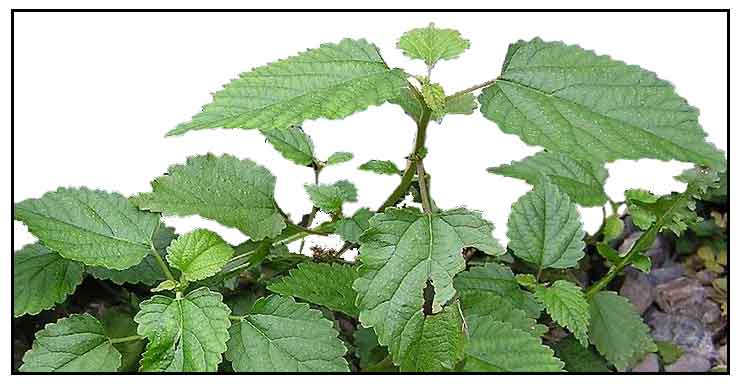 Botany Botany
Sikir is an ascending or erect, slightly branched, half-woody, slightly hairy perennial herb, 50 centimeters high or less, with slender, terete branches. Leaves are ovate to ovate-lanceolate, 2 to 6 centimeters long, and 1 to 4 centimeters wide, the tip pointed, and broad at the base, truncate or somewhat heart-shaped, 3-nerved, with crenate-dentate margins. Fruit is usually a drupe, rarely an achene, enveloped by an enlarged calyx or immersed in a fleshy receptacle. Seed is solitary.
Distribution
- In dry thickets, on walls, cliffs, etc. at low altitudes from northern Luzon to Mindanao.
- Also occurs in Japan and China, and southward to Malaya.
Properties
- Febrifuge, diuretic.
- Plant reported to cause itching of mild degree.
(4)
Constituents
-
Study of the whole plant yielded six new prenylcoumarins: (+)-fatouain A, (−)-fatouain B, (+)-fatouain C, (−)-fatouain D, (+)-fatouain E, and (−)-fatouain F, along with two new bis-prenylcoumarins, (+)-fatouain G and (+)-fatouain H. (1)
-
Study isolated umbelliferone, phellodenol A, psoralen and scopoletin, bergapten, (+)-(S)-marmesin, (+)-(S)-rutaretin, and xanthyletin from the whole plants of Fatoua pilosa. (See study below) (5)
- Study reports calcium carbonate in the leaves--cytoliths were located in the epidermal lithocysts. (6)
- Study isolated three new alkylated chalcones, villosins A-C (1-3), five known analogues, together with ten known coumarins. (see study below) (7)
Parts used
Fresh roots.
Uses
Folkloric
- In the Visayas, decoction of fresh roots is given in fevers.
- Also effective for swollen gums when used as a gargle.
- Infusion of roots used for irregular menstruation.
- Root infusion also
used as diuretic.
Studies
• Prenylcoumarins / Fatouains: Study of the whole plant yielded six new prenylcoumarins: (+)-fatouain A, (−)-fatouain B, (+)-fatouain C, (−)-fatouain D, (+)-fatouain E, and (−)-fatouain F, along with two new bis-prenylcoumarins, (+)-fatouain G and (+)-fatouain H. (1)
• Fatouapilosin / Antimycobacterial: Study yielded one novel dimeric coumarin analog, fatouapilosin, together with 18 known compounds. Compounds 3, 12, and 14 exhibited the strongest antimycobacterial activities against Mycobacterium tuberculosis H37Rv. (2)
• Coumarins / Umbelliferone and Scopoletin / Antimycobacterial: Study isolated umbelliferone, phellodenol A, psoralen and scopoletin, bergapten, (+)-(S)-marmesin, (+)-(S)-rutaretin, and xanthyletin from the whole plants of Fatoua pilosa. Umbelliferone and scoploletin exhibited antimycobacterial activity. (5)
• Cytotoxic Chalcones /
Human Tumor Cell Lines: Study isolated three new alkylated chalcones, villosins A-C, along with 10 known coumarins. Compounds 1-3 showed cytotoxicity against five human tumor cell lines (NBA, A549, SHSY5Y, PC3, and MCF7) with IC values ranging from 1.4 ± 0.1 to 5.7 ± 0.3 µM. (7)
Availability
Wild-crafted.
|

![]()




